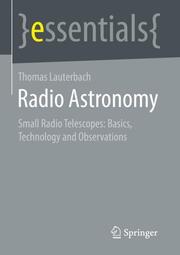Detailansicht
Radio Astronomy
Basics, Technology, and Observation Capabilities of Small Radio Telescopes, essentials - Springer essentials
ISBN/EAN: 9783658360344
Umbreit-Nr.: 2936966
Sprache:
Englisch
Umfang: X, 57 S., 26 s/w Illustr., 3 farbige Illustr.
Format in cm:
Einband:
kartoniertes Buch
Erschienen am 09.03.2022
Auflage: 1/2022
- Zusatztext
- Radio technology enables the extension of astronomical observations beyond light to other frequency ranges. This has led to the discovery of numerous cosmic radio sources, the physical causes of which are explained as well as how a radio telescope works. Even small radio telescopes can observe radiation from the Sun and other radio sources, as well as the 21-cm radiation from the Milky Way. Through interferometry, much higher resolution can be achieved than with individual radio telescopes. As a result, radio astronomical research can contribute to many current questions in astronomy, cosmology, and physics. This Springer essential is a translation of the original German 1st edition essentials, Radioastronomie by Thomas Lauterbach, published by Springer Fachmedien Wiesbaden GmbH, part of Springer Nature in 2020. The translation was done with the help of artificial intelligence (machine translation by the service DeepL.com). A subsequent human revision was done primarily in terms of content, so that the book will read stylistically differently from a conventional translation. Springer Nature works continuously to further the development of tools for the production of books and on the related technologies to support the authors.
- Kurztext
- Radio technology enables the extension of astronomical observations beyond light to other frequency ranges. This led to the discovery of numerous cosmic radio sources, the physical causes of which are explained, as is the operation of a radio telescope. Even small radio telescopes can observe radiation from the Sun and other radio sources, as well as 21-cm radiation from the Milky Way. Through interferometry, a much higher resolution can be achieved than with individual radio telescopes. As a result, radio astronomical research can contribute to many current questions in astronomy, cosmology, and physics. This Springer essential is a translation of the original German 1st edition essentials, Radioastronomie by Thomas Lauterbach, published by Springer Fachmedien Wiesbaden GmbH, part of Springer Nature in 2020. The translation was done with the help of artificial intelligence (machine translation by the service DeepL.com). A subsequent human revision was done primarily in terms of content, so that the book will read stylistically differently from a conventional translation. Springer Nature works continuously to further the development of tools for the production of books and on the related technologies to support the authors. The Contents Brief outline of the history of radio astronomy and its discoveries. Electromagnetic waves Cosmic radio radiation How a radio telescope works Typical observations with a small radio telescope Interferometry, current research topics in radio astronomy and own introduction to radio astronomy The Target Group Anyone who is looking for a compact introduction to radio astronomy, whether at universities, schools, observatories, or out of personal interest. The Author Thomas Lauterbach is professor of physics at the Nuremberg Institute of Technology (Technische Hochschule Nürnberg Georg Simon Ohm) and head of the radio astronomy special interest group of the Astronomical Society in the European Metropolitan Region Nuremberg.
- Autorenportrait
- Thomas Lauterbach is professor of physics at the Nuremberg Institute of Technology (Technische Hochschule Nürnberg Georg Simon Ohm) and head of the radio astronomy special interest group of the Astronomical Society in the European Metropolitan Region Nuremberg.
